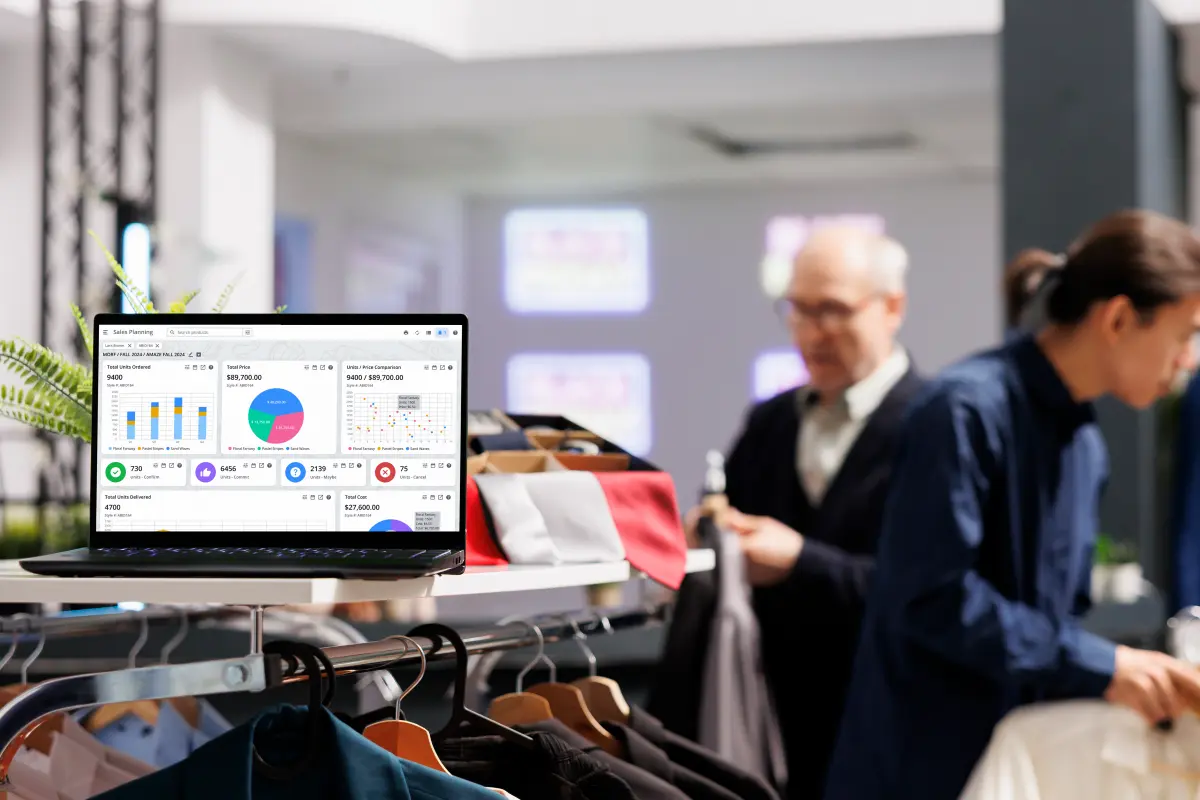
Fashion moves fast. Consumer preferences evolve constantly, driven by trends, social media, and new technologies. To keep up, brands need quick and efficient systems that balance creativity with market demands. Fashion product planning has become more complex than ever, involving many moving parts, from design to production.
Enter Product Lifecycle Management (PLM) software and Digital Sales Boards. Together, they streamline product development and help brands make smarter, data-driven decisions. This article explores how digital sales boards revolutionize fashion product planning and reshape sales management while driving the digital transformation in fashion.
PLM Software: The Backbone of Fashion Product Planning
Before diving into Digital Sales Boards, let’s talk about PLM software. PLM systems have become essential for fashion brands managing complex processes. They act as a central hub, connecting teams and departments while tracking every aspect of a product’s journey.
Fashion PLM software covers:
- Design management: Centralizing technical files, design guides, and color options.
- Material sourcing: Managing suppliers and fabric details.
- Production schedules: Tracking timelines to ensure on-time manufacturing.
- Compliance: Verifying that all products meet regulatory standards.
By connecting these functions, fashion PLM enhances communication between teams. This coordination minimizes delays, reduces errors, and ensures efficient workflows. But, brands don’t just need good products — they must produce the right ones, in the right quantities, at the right time.
This is where Digital Sales Boards come into play.
Digital Sales Boards: A Game-Changer for Fashion Brands
A Digital Sales Board helps brands manage their sales pipeline and track product performance. It replaces outdated, manual systems with an interactive, visual platform that updates in real time. The key features include:
- Real-time data: View live sales across regions and channels.
- Portfolio visualization: See your collections and stock levels at a glance.
- Sales forecasting: Predict future demand based on current trends.
- Collaborative interface: Sales, marketing, and design teams can all contribute in real-time.
These boards allow brands to adjust strategies quickly and align their product offerings with market demands. By providing real-time data, they offer actionable insights into what products perform well, enabling better planning and inventory control.
The Power of Combining PLM Software with Digital Sales Boards
The integration of PLM software and Digital Sales Boards creates an end-to-end system for fashion product planning. This partnership breaks down silos and connects product development with sales management. Here’s how:
1. Enhancing Team Collaboration
In many fashion brands, departments like design, sales, and marketing often work in isolation. Designers focus on creativity, sales looks at numbers, and marketing tries to bridge the gap. These disconnections cause delays and confusion.
When you integrate Digital Sales Boards with fashion PLM, everyone works from the same data. Teams collaborate smoothly, exchanging updates and feedback in real-time. For example, if the sales team spots a drop in a collection’s performance, they can share that data with designers immediately. Designers can then tweak future collections to match consumer preferences.
This constant communication fosters smarter, faster decision-making and reduces the risk of producing unwanted styles.
2. Real-Time Data for Better Decision-Making
Trends change fast, and fashion brands can’t afford to rely on outdated data. They need real-time insights. Digital Sales Boards deliver up-to-the-minute sales data, empowering brands to pivot quickly.
When you combine Digital Sales Boards with PLM software, you get data tied directly to product development. For instance, if a specific collection outperforms expectations, teams can quickly scale up production. On the flip side, if demand dips, they can cut production to avoid excess inventory.
Real-time data enables brands to respond instantly to market changes, preventing lost opportunities.
3. Bridging Product Development and Sales
Fashion brands often separate product development from sales. Designers create based on their vision, while the sales team focuses on revenue. This disconnect leads to products that may not align with market needs.
Digital Sales Boards, integrated with fashion PLM systems, close that gap. Sales teams can track each product’s development stage. Designers can adjust their work based on sales performance. If certain fabrics or colours sell well, designers can prioritize similar options for future collections.
This collaboration ensures that future designs match consumer demand, lowering the risk of unsold inventory.
4. Improving Merchandising and Inventory Control
Merchandising hinges on accurate sales and inventory data. Without it, teams struggle to present products in the most effective way. Digital Sales Boards simplify this by providing a clear view of product performance and stock levels.
When you link Digital Sales Boards to apparel PLM, merchandising teams can quickly identify which products need promotion. They can also see where stock is running low and adjust displays or campaigns accordingly. For instance, if a product sells well in one region, it can ramp up local marketing efforts or increase inventory for that area.
On the other hand, underperforming products can be removed or discounted to make room for new arrivals. This dynamic merchandising ensures brands maximize their selling potential.
5. Accurate Sales Forecasting
Overproduction or underproduction can devastate fashion brands. Too much inventory leads to markdowns, while too little means lost sales. Accurate sales forecasting helps brands find the balance.
Digital Sales Boards provide real-time insights into sales trends, helping teams predict future demand. When integrated with PLM software, sales forecasts become even more precise. Brands can adjust production plans based on current market performance and historical trends.
For example, if a product line trends upward, brands can increase production to meet future demand. If sales slow down, they can reduce production to avoid overstock. This accurate forecasting helps brands optimize production and boost profitability.
6. Speeding Up Time to Market
Fashion brands that move fast gain a competitive edge. Consumers expect brands to respond quickly to trends and new designs. Digital Sales Boards and PLM software help brands accelerate the entire process from product development to sales.
By offering real-time updates on product development, Digital Sales Boards allow brands to address bottlenecks quickly. For example, if a supplier delays a material shipment, the production team can immediately find an alternative supplier.
This ability to respond in real-time reduces lead times and ensures products hit the market faster. The faster a brand launches its collection, the better it can capitalize on trends and consumer interest.
The Importance of Digital Transformation in Fashion
Integrating Digital Sales Boards with fashion PLM software plays a crucial role in the digital transformation in fashion. As brands strive to keep pace with changing trends and consumer expectations, digital tools like these help them stay competitive.
Automation, real-time data, and collaboration are essential for any fashion brand aiming for success. By using these technologies, brands can make faster, more informed decisions and reduce time to market.
Fashion’s fast-moving nature demands quick responses, and digital transformation ensures that brands can adapt to changes, keeping them relevant and ahead of the curve.
Conclusion: The Future of Fashion Product Planning
Digital Sales Boards and PLM software form a powerful combination that revolutionizes fashion product planning. They break down silos, speed up processes, and provide the real-time data needed for agile decision-making.
Brands that embrace these tools position themselves to respond quickly to market demands. They also ensure their teams stay aligned, reducing miscommunication and inefficiencies. Whether you manage a large fashion house or a small brand, the combination of Digital Sales Boards and PLM software represents the future of product planning and sales management.
The digital transformation in fashion is here, and those who adapt will lead the way in a fast-changing market. With these tools, brands gain better control over product development, merchandising, and inventory, all while maximizing profitability. Stay agile, stay informed, and stay ahead by integrating Digital Sales Boards and fashion PLM software into your fashion product planning strategy.






Leave a Reply